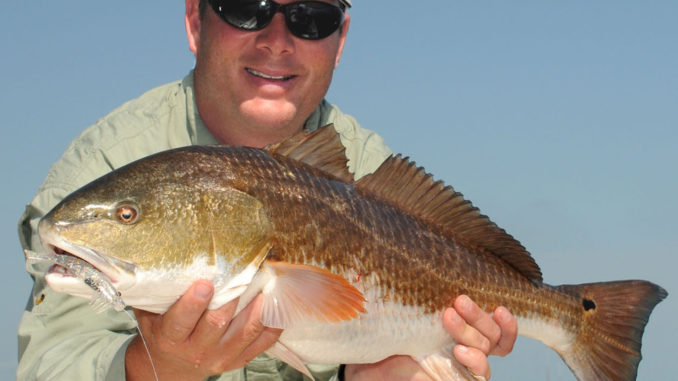
Soft-plastic crustaceans are the ticket this month to catching redfish in this Charleston area river. Here’s why…
As the summer sun resets towards its fall position, redfish are in transition up and down South Carolina’s coast as forage species begin to relocate. And the Wando River, which begins and ends within Charleston County’s borders, supports a massive shrimp population that fires up the feisty reds that call it home. Beginning this month and continuing into the fall, anglers can home in on the Wando River for their redfish fix.
The waters around Charleston are some of the best places in South Carolina to float a boat and wet a line during the early fall. Of the four — the Stono, Cooper, Ashley and Wando — only the Cooper has a wide drainage. The other three originate a relative few miles from Charleston Harbor, and because they drain relatively small areas, they remain more stable and create ideal nursery grounds for small fish, and of course, shrimp.
Shrimp is sort of the glue of the ocean. There are very few fish that will not devour a shrimp at any time of the year. Shrimp in South Carolina waters are either brown, pink or white, and since white shrimp never leave the ocean, the pinks and browns are the primary shrimp eaten by inshore redfish.
As the water temperature begins to drop this month, the millions of brown shrimp, aka grass shrimp, prepare to evacuate the protected marshes up in the Wando to make their way to their spawning grounds in the ocean. And this is when Capt. Jeff Yates of TyJo Knot Charters relies on shrimp and shrimp imitations to catch his inshore prizes.
“The shrimp are about the thickest in September as they will ever get,” said Yates (843-270-8956). “It’s when the kids go back to school.”
Typically, these shrimp will stay up in the creeks and scatter across the super-shallow mud flats well away from the main river channel through the summer, but September is different. The shrimp begin to collect in the feeder creeks and head for the main river channel.
“Every little shrimp is falling out to the main river preparing to make their move. They will be migrating soon, and they will be very thick in September and October in the Wando,” Yates said.
The redfish that normally cruise the grass-covered mud flats have also pulled out of their normal summer scavenging mode and shift to more of a gluttonous rampage, with shrimp at the top of their menu.
“This is when the reds are at their thickest. They get shoulder to shoulder and cruise 15-fish wide down the banks at low tide,” says Yates.
Capt. Amy Little of Fine Lines Charters fishes the Wando during the fall for redfish right when the shrimp are at their thickest.
“During the late summer and early fall, shrimp are the primary food source for redfish in the Wando,” said Little (843-345-1310). “I find the largest concentrations of shrimp and redfish along exposed, muddy banks near creek mouths.”
Luckily, reds are not the only predator species participating in these gluttonous behaviors. Seagulls and other avian scavengers will pinpoint concentrations of shrimp when redfish have them gaggled up.
Yates always keeps his eyes open for a collection of birds off in the distance.
“September is the time when you are looking for birds hovering down the edges. It is awesome to see the schools of reds plowing across a school of shrimp with birds overhead marking their way,” he said. “In September, I am looking for flats and birds.”
Sometimes, the birds may not be on their game, and the redfish may be eating alone. Even though the shrimp are mostly exposed along these mud banks, they will seek shelter and protection from any type of structure that is around. Yates prefers to fish on the low end of the tide cycle and will look for mud flats with oysters.
“The big oyster beds are supposed to hold more fish, but sometimes the small oyster beds will surprise you,” he said.
During the feeding frenzy, anglers can have success using a wide variety of baits and lures, but anything that resembles a shrimp is going to be No. 1. Both Yates and Little use a full assortment of artificial offerings for September redfish.
“Artificial lures can work well even with the heavy presence of live shrimp,” said Little, “but presentation is everything. You want a natural presentation of bait trying to escape a predator and not of a shrimp being aggressive. Put it in front of him, but far enough away so as not to spook him.”
Little will use a variety of artificials during the fall, but she will keep one brand well stocked.
“Egret Bait’s Vudu line is my favorite artificial shrimp because of their quality, life-like features. The Kevlar fabric throughout the body and segmented tail mimics the movements of real shrimp when moved through the water,” said Little, who uses the standard 3-inch model mostly in magic and natural colors.
A natural presentation is a key for anglers to compete with the thousands of real shrimp in the water column. However, Little tries to use colors that are very visible under different water conditions.
“When the water is clear, I want my baits to look as natural as possible,” she said. “When the water is dirtier, I like to use brighter baits for the contrast and easier visibility for the redfish.”
No. 1 on Little’s list and Yates’ No. 1 imitation shrimp is the original 3-inch D.O.A. shrimp. She uses the chartreuse, pearl and others tipped with the orange firetail.
“I like the firetail colors in murkier water,” said Little, who believes the added orange on the tip of the tail adds just enough color to catch the eye of passing reds.
Yates uses three basic colors of D.O.A. shrimp and all have glitter as part of the color palate.
“D.O.A. shrimp are the only shrimp I’ll have in my boat that are not alive and kicking around,” he said. “I use the 3-inch or ¼-ounce size, and the gold glitter is my ‘go-to’ color, but I also like silver glitter and holographic glitter.”
The best of the dozens of different shrimp imitations on the market are the ones that maneuver most naturally in the water column. Typically, shrimp use their legs to walk along the bottom to feed, but often the current will pull them up into the water column or they will use their tail to propel themselves backwards. Afterwards, they will settle back to the bottom to either get out of the current or to start foraging again. D.O.A, Vudu and other good imitation shrimp will settle right-side up and not on its side looking lifeless.
DESTINATION INFORMATION
HOW TO GET THERE/WHEN TO GO — The Wando River empties into Charleston Harbor between Mt. Pleasant and Daniel Island. The most-popular and most-accessible boat landing is at Remley’s Point off Mathis Ferry Road in Mt. Pleasant. On the upper Wando, Paradise Boat Landing at the end of Chandler Road off US 17 is available for small johnboats and kayaks. The public access on Shem Creek at the end of Mill Street in Mt. Pleasant is also convenient. The redfish bite cranks up when shrimp begin to stack up in the river’s main channel, normally in September. The action will continue well into the fall.
TACKLE/TECHNIQUES — Soft-plastic imitation shrimp and live shrimp can be fished on cork rigs on a 24- to 36-inch fluorocarbon leader or cast without weight on medium- to light-action spinning gear spooled with 20-pound braid. Fishermen should cast upcurrent and use their rod tips to twitch the lures every few seconds during the retrieve.
FISHING INFO/GUIDES — Capt. Jeff Yates, TyJo Knot Charters, 843-270-8956, www.inshorefishingcharleston.com; Capt. Amy Little, Fine Lines Charters, 843-345-1310, www.finelinescharters.com; Haddrell’s Point Tackle, Mt. Pleasant, 843-881-3644. See also Guides and Charters in Classifieds.
ACCOMMODATIONS — Hampton Inn-Patriots Point, Mt. Pleasant, 843-881-3300; Charleston Area Convention & Visitors Bureau (www.charlestoncvb.com), South Carolina Association of Visitors Bureaus (www.discoversouthcarolina.com).
MAPS — Navionics, 800-848-5896, www.navionics.com; Capt. Segull’s Nautical Charts, 888-473-4855, www.captainsegullcharts.com; Sealake Fishing; Guides, 800-411-0185, www.thegoodspots.com.

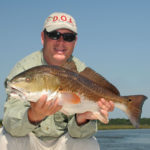
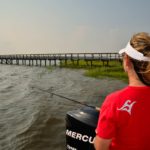
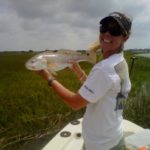
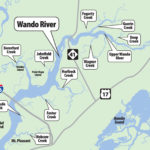




Be the first to comment